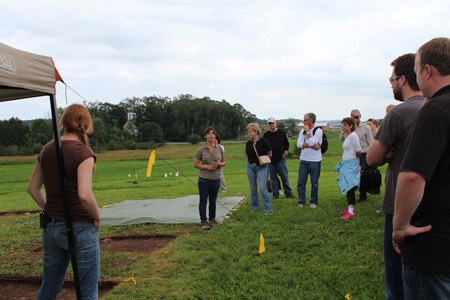Finding Avenues to Implement Historical Thinking Into the Classroom (Jill Colyer)

The Historical Thinking Project (2009-2014)
For five years I was the national coordinator of the Historical Thinking Project (HTP). In this role, I was the bridge between the research on historical thinking – as conceptualized by Professor Peter Seixas and his colleagues at the Centre for the Study of Historical Consciousness (CSHC) at the University of British Columbia – and the school community in Canada. Among other things, this meant that I worked with curriculum specialists at ministries of education across the country as they revised their social studies and history guidelines, and facilitated large-scale professional development (PD) sessions with educators on how to integrate historical thinking concepts into instruction and assessment practices.
The Historical Thinking Project was unique in that it was able to take the theory and research on how best to learn history and then work to have that research implemented into classrooms. All too often the excellent research that is conducted by academics stays within the academic community and does not have a chance to change practice in classrooms.
Federal funding for the Historical Thinking Project with its vision of developing historical thinking in students was discontinued and the Project went into hiatus on March 31, 2014. Peter Seixas and staff at the CSHC maintain the HTP website and continue to run summer institutes for educators, but other initiatives of the Project are on hold until other sources of funding are located.
Growth of Historical Thinking Implementation (2014 and beyond)
 Fears that the end of the HTP would stall the integration of historical thinking into classrooms across Canada have proven to be largely unfounded. Because curriculum adoptions of historical thinking had occurred in six provinces – with another two currently under revision/adoption – ministry officials and educators in these provinces and territories are driving the creation of new resources and professional development for teachers.
Fears that the end of the HTP would stall the integration of historical thinking into classrooms across Canada have proven to be largely unfounded. Because curriculum adoptions of historical thinking had occurred in six provinces – with another two currently under revision/adoption – ministry officials and educators in these provinces and territories are driving the creation of new resources and professional development for teachers.
In Manitoba, for example, a comprehensive adoption of the historical thinking concepts into the curriculum guidelines for Grade Eleven Canadian History was followed by the production of a Grade Eleven History textbook for students and supporting resources for teachers. The Manitoba Social Studies Teachers’ Association conference always features a number of presenters working with historical thinking at the primary/junior, intermediate, and secondary levels, and in museum exhibits and installations.
In Ontario, the Ministry of Education has adopted the historical thinking concepts across all twelve grade levels. This means that students begin working with these concepts in Grade One and develop increasingly sophisticated understandings of the concepts as they proceed through subsequent grade levels.
Since the end of the project, I have been working as an independent consultant and can see that just as the Historical Thinking Project was a bridge between historical thinking research and classroom practice, I continue to be a link between the theory that underpins disciplinary thinking and inquiry and the nuts and bolts implementation in the classroom. I continue to work with educational publishers who are trying to develop resources to support students and teachers in classrooms, run PD workshops that focus on helping educators understand and teach with the concepts, and teach Additional Qualifications (AQ) courses at faculties of education that feature the historical thinking concepts – in fact, the Ontario College of Teachers mandates that the concepts be taught in all history AQ courses in that province.
My current work with the Ontario Ministry of Education is to develop a series of teaching and learning examples that focus on integrating both Aboriginal ways of knowing and disciplinary thinking concepts into social studies and history classrooms. In the fall, the focus of my work will shift to assessment and evaluation at the Ministry.
I think that the Historical Thinking Project acts as an excellent model for all academic disciplines to integrate knowledge of best practice instructional and assessment models into classrooms. I know that at least one other subject-discipline is working towards establishing such a project, but it would be great to see others as well so that we can all help to facilitate the creation of a culture of exploration, curiosity, and deep thinking in classrooms across Canada.
Photo: Participants at archaelogical site at 2013 Halifax HTP Summer Institute

